Beware of ticks! How to protect the child and remove a tick if it bites?

The onset of summer initiates an active period of walks and trips to the countryside with children. However, it is not only children and their parents that “wake up” after the cold weather: higher temperatures also activate the ticks.
During this period, most parents are concerned about how to protect their child, what to do if a tick is bitten during the walk and how to remove a tick. We will discuss whether it is possible to get a tick out by yourself and what cannot be done in this situation, as well as how this affects the well-being of the child, in this article.
Check if your child is going on a walk in a safe place and suggest the pathway for them to take. Get an instant SOS signal in case of an emergency. Download the Findmykids app from AppStore or GooglePlay.
Contents:
- What does a tick look like?
- The danger of ticks
- Where does the tick bite most often?
- First aid to a child in the event of a tick bite
- First alarming symptoms
- Preventative measures and best tick remedies for children
- Tick-borne encephalitis vaccine
What does a tick look like?
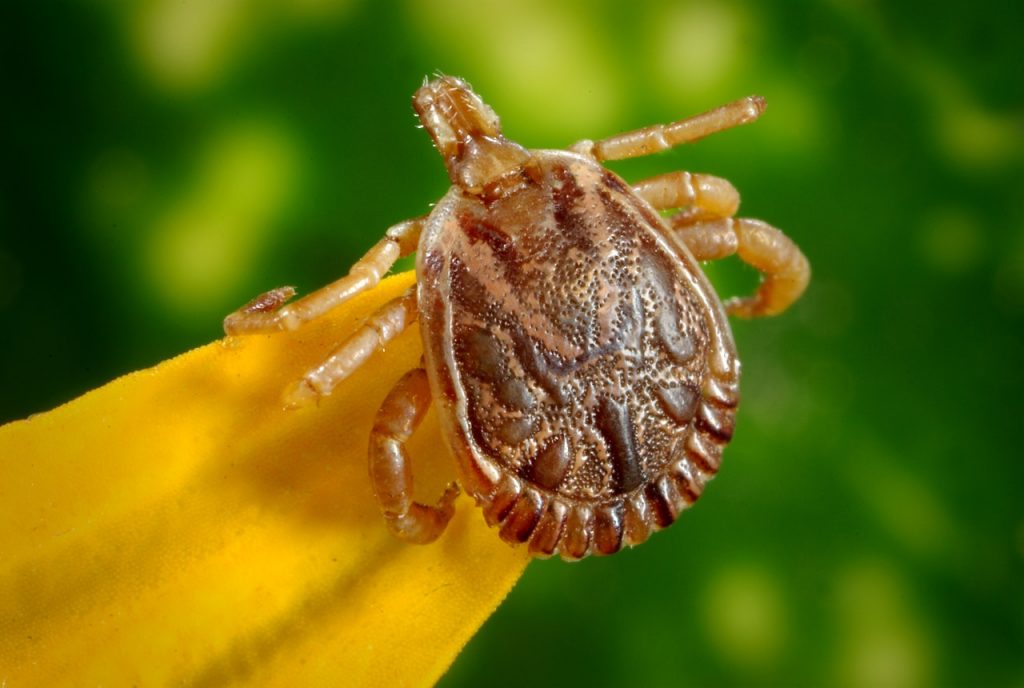
Prostock-studio/Shutterstock.com
Ticks are blood-sucking parasites that belong to the animal kingdom (it is a mistake to believe that they are insects). Their elongated oval body consists of a cephalothorax and an abdomen with 4 pairs of legs. Their feeding structure is capable of biting through the skin of humans and mammals.
Colour
Their color can vary from black, to brown (from light brown to dark), to beige. Moreover, a variety of spots and blotches can be found on the surface of the tick’s body.
Size
The size of a tick that has not drunk any blood yet, is 2 to 4 mm, making it rather difficult to notice them on the skin or on clothes. After the tick has “feasted” on the blood of its victim, its size increases by 3-4 times, sometimes reaching up to 1-1.5 cm. They adopt a spherical shape in this state.
The ideal temperature for the activity of ticks ranges between +7 and +25 degrees Celsius. They prefer a humid climate and cannot survive during hot and dry seasons.
The danger of ticks

Prostock-studio/Shutterstock.com
It should be noted that despite the widespread opinion, ticks do not know how to climb the tops of trees and jump from above. On the contrary, they live in low bushes and grass, therefore, the risk factor for people is higher at ground level.
These blood-sucking parasites carry a dozen diseases that can infect humans. Here are some of them:
- tick-borne borreliosis (Lyme disease);
- tick-borne typhus;
- tick-borne encephalitis;
- tularemia;
- ehrlichiosis.
Tick-borne encephalitis is not a disease that can often be found in the US, although it does exist in Europe with dense forest areas.
It is not possible to determine whether a tick carries the disease by its appearance. Only lab methods in special hospitals can confirm or deny the presence of a particular disease in a tick.
Tick-borne encephalitis
Tick-borne encephalitis is a dangerous viral infection that is accompanied by a febrile condition and disruption of the central nervous system. The first symptoms do not appear immediately as the incubation period can last between 10 and 14 days.
Symptoms of tick-borne encephalitis:
- increased body temperature;
- headache;
- redness of the skin of the face and neck;
- chills;
- muscle pain;
- photophobia.
Due to the spreading of the virus in the spinal cord and brain, neurological disorders appear, such as delirium, hallucinations, cardiac and respiratory problems. In a severe stage of the disease, meningitis occurs. It is an acute inflammatory disease of the membranes of the brain and spinal cord which often leads to disability and death.
Encephalitis is treated at the hospital under the strict supervision of doctors with immunoglobulins, anti-inflammatory drugs, and anticonvulsants.
It is important to note that the transmission route of tick-borne encephalitis virus is through tick bites. However, cases of infection through food also exist, for example, through the milk of a cow that was previously bitten by an infected parasite.
Lyme borreliosis (Lyme disease)

Prostock-studio/Shutterstock.com
Credit – Guswen, https://commons.wikimedia.org/.
Tick-borne (Lyme) borreliosis is an infectious disease that begins as a common cold. However, it is much more dangerous, as it damages the skin, the cardiovascular system, and affects large joints. Its incubation period ranges from several days to a month. Initially, a skin rash called erythema migrans appears.
Infected tick bite symptoms:
- rash on the body;
- headache;
- fever;
- feeling of stiffness in movements and joint pain;
- enlarged lymph nodes;
- disorders of attention, sleep, vision (at a later stage).
Treatment for it takes place in a hospital and includes antibiotic therapy and symptomatic medicine. This disease can develop into a chronic form and disturb a child or an adult for six months or even a year after a tick bite.
The first symptoms of tick-borne encephalitis and Lyme disease can be easily confused with a cold. Therefore, it is very important to seek immediate medical attention in order to diagnose the patient.
According to the official CDC statistics, in 2019, the US had 50 865 cases of tick bites reported, which is equal to only 10% of the number of cases in Russia, for instance. This number remains relatively stable over the last 5 years with no major year-on-year fluctuations. Nevertheless, the cases of Lyme diseases and other serious diseases carried by ticks have more than doubled in the US over the last decade.
Where does the tick bite most often?

Prostock-studio/Shutterstock.com
According to the statistics, ticks are found in children and adults in different areas. Here are the favorite places for parasites on a child’s body:
- scalp;
- behind the ears;
- back;
- neck and chest;
- armpits.
In adults, bites are most often encountered on the arms, chest, and in the armpits.
When a tick hits the skin, it not only bites its victim but also secretes a special substance that holds them firmly on it. Because of this, they can stay on the body for a long time until they are completely saturated with blood.
If the tick gets attached onto shoes or trousers, it will crawl up and to the sides until it finds an open area of skin. In this case, it can be easily shaken off the clothes, as it firmly “bites” into the skin as soon as it reaches its surface.
It is worth noting that infectious pathogens are found in the tick’s abdomen, so if you carefully remove it, you can protect the child from the infection.
What does a tick bite look like?

Prostock-studio/Shutterstock.com
Be sure to examine the child’s body and scalp after a walk. The bite on the skin looks like a red spot about 1-1.5 cm in size, from which you can be able to see the tick’s body sticking out.
The tick does not get under the skin fully: only the head section with a piercing-sucking apparatus is immersed, with their body located above the skin.
The child may not feel the actual bite as the tick secretes a special substance to anesthetize the site of the bite. In addition, the size of the parasite is so small and its piercing apparatus is very insignificant, even compared to a mosquito bite.
First aid to a child in the event of a tick bite
Nevertheless, if the parent has found a tick on the body of their child after a walk, it is necessary to provide assistance to them. The first step is to reassure the child and explain that the parasite needs to be removed and that it is painless, however, it must be done carefully.
Be careful: you cannot touch the parasite with your bare hands, as any careless movement will lead to crushing it and infecting you as a result.
How to remove a tick?
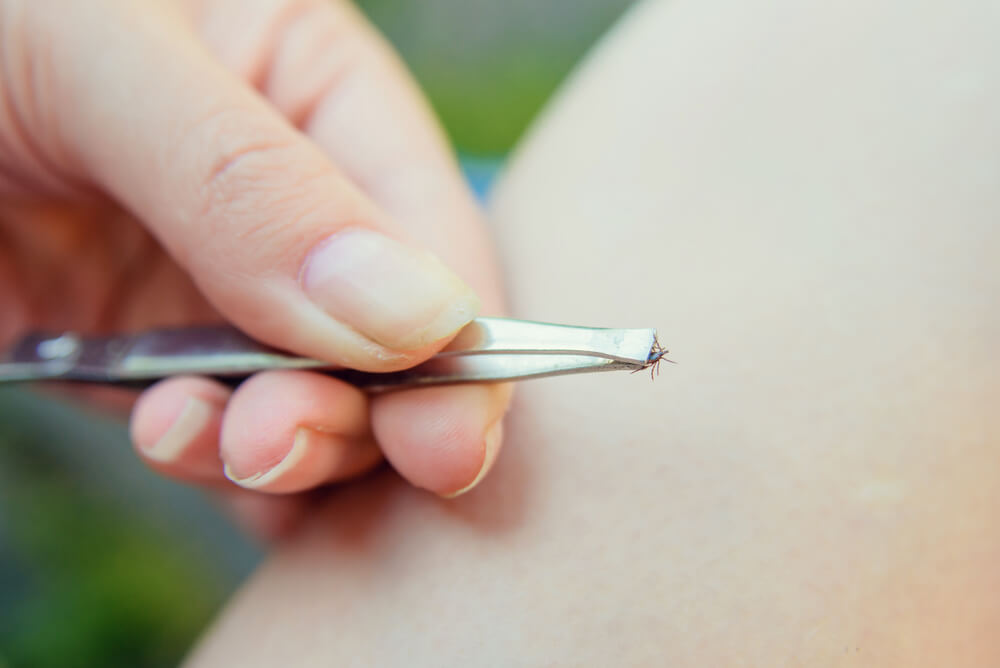
Prostock-studio/Shutterstock.com
Parents often ask themselves the question of whether they should take their child to the hospital or get the tick out by themselves. The most important thing is to get the tick out as soon as possible so that it does not have time to infect its victim. Until the parent gets their child to the hospital, valuable time can be lost.
At-home options
1. With the use of tweezers
You need to take thin tweezers and grasp the parasite as close to the skin as possible (not by the abdomen) and gently pull it. Be attentive and you will be able to pull it out completely.
People who live in epidemiologically unfavorable areas with a prevalence of ticks have special thin tweezers designed to extract parasites. They are small in size and are suitable for removing ticks from any part of the body.
2. With a thread
A synthetic thread of 35-40 centimeters is taken. A loop of thread is thrown over the tick to allow it to get into the loop. The loop is then tightened and the thread is twisted. After that, the thread is pulled out.
If, after removing the tick, its head remains under the skin, you will need to get it out too. You must treat it as an ordinary splinter: treat the skin with something to disinfect it and take it out with tweezers. Do not worry: the head that remains in the skin does not contain infectious pathogens, nevertheless, you will still need to remove it fully.
What must not be done:
- pulling the tick by the abdomen: it will come out while its head will remain under the skin. Therefore, there will be more unpleasant trouble for the parent and the child, since the tick’s head must be taken out entirely;
- touching the tick with bare hands (it is better to use medical gloves);
- crushing the tick’s body as it contains infectious agents, which, when crushed, can get both under the skin of the parent and the child;
- for the reason described above, you cannot squeeze the parasite out of the skin like a pimple;
- trying to wet the tick with some kind of solution in the hope that it will come off the baby’s skin by itself, as this is impossible. Vegetable oil, sprays, hairspray, kerosene, liquid soap, creams, and other handy solutions will not force the tick to come off the skin. They will only scare them, forcing them to inject more infectious toxins under the child’s skin.
It is a mistake to believe that vegetable oil is able to block the access of oxygen to the tick’s body, supposedly leading to its death and allowing it to fall off the site of the bite. This parasite does not need a lot of oxygen, and it will take a very long time for them to die in such a situation.
How to treat the area of the bite?
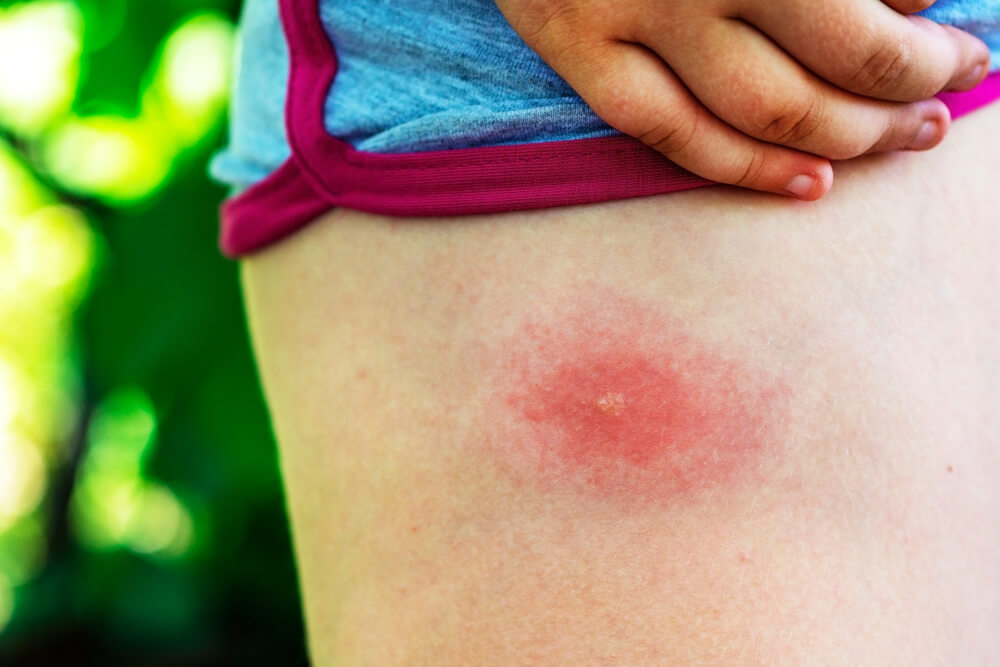
Prostock-studio/Shutterstock.com
When the parasite is completely removed, a small reddish wound remains on the child’s skin. Its diameter can be different, ranging from one to several centimeters. Proceed to do the following after removing the tick:
- The parent needs to make sure that the tick is removed completely.
- Gloves that were used to take the parasite out must be carefully removed and disposed of.
- The surface of the baby’s skin should be washed with soap and water.
- Treat the skin with an antiseptic solution that contains alcohol or, if it is not available, sprinkle cologne on the skin. Repeat the procedure the next day after the bite.
What to do after?
After the parent has taken the tick out, they need to write down the date of when it happened. Of course, you can hope for the parasite to turn out non-infectious, however, you don’t need to take any chances with that.
The tick should not be thrown away immediately. It must be placed in a glass jar with a wet cotton round in it and taken to the medical laboratory. This will be the most ideal option since a lab analysis will be able to tell for sure whether the tick was infectious or not.
Nevertheless, there are a few precisions to make in here:
- only a whole tick is accepted in the laboratory, and removing it unharmed is a very difficult task;
- only a live parasite is accepted;
- not every clinic will be able to do such tests, so you need to call a few of them in advance to enquire;
- the analysis is likely not to be free.
If the whole insect could not be removed, then the best way to get rid of it is by putting it in an oven or burning it in a fire.
In any case, whether you passed the tick to the lab or not, you need to observe the child and, if the first symptoms appear, consult a doctor and tell them when the bite took place and when did the first symptoms start manifesting themselves, etc.
First alarming symptoms
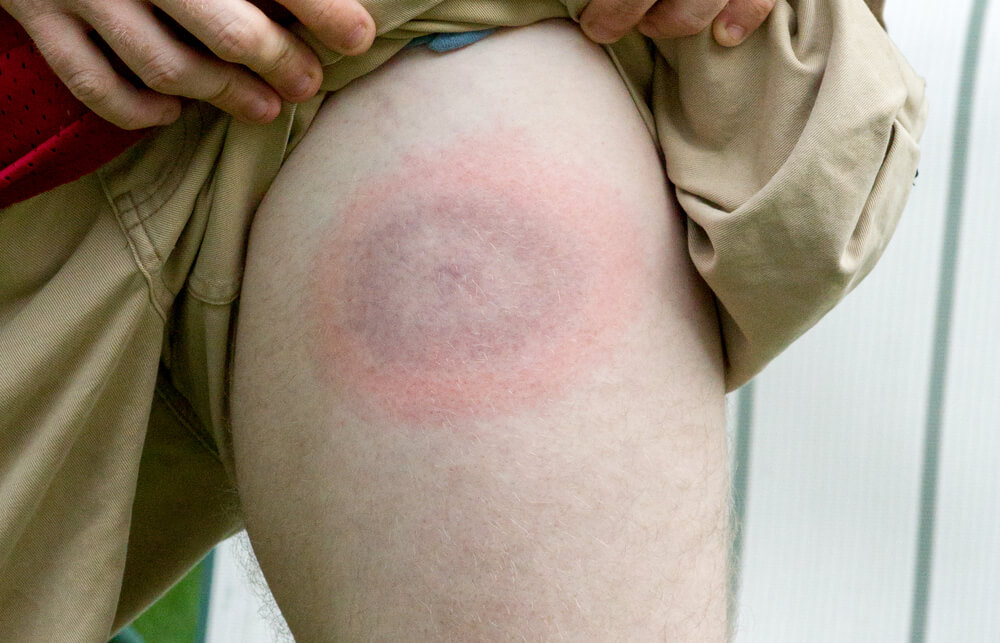
Prostock-studio/Shutterstock.com
Lyme disease symptoms.
As mentioned earlier, the first symptoms of tick-borne encephalitis and Lyme disease do not appear immediately. On average, they start becoming noticeable 2 weeks after the bite. You need to consult a pediatrician urgently if a child has got the following:
- fever, increased body temperature;
- weakness, lethargy, drowsiness;
- headache;
- loss of appetite;
- nausea, vomiting;
- red rash on the body;
- disorders of consciousness;
- paresis of the limbs (decreased muscle strength).
The tick-borne encephalitis virus first enters into the child’s blood through a bite. It then spreads through the bloodstream, firstly, to the lymph nodes, internal organs, and then to the brain and the spinal cord. When the amount of virus in the blood increases (viruses multiply and increase their count), the first symptoms start appearing.
As for Lyme disease, the first symptom is a rash on the body with red spots of various diameters, from 0 to 60 cm. There may be no other symptoms at first. When such spots appear, parents turn to allergists or dermatologists, thinking that this is an allergic reaction or dermatitis. However, if two weeks or even a month pass after a tick bite and symptoms persist, it can be assumed that the child begins to develop tick-borne borreliosis.
Tick bites are dangerous, therefore, you need to consult a doctor at the first declaration of such symptoms. A blood test will be performed at the hospital, the cause of the child feeling unwell will be identified and medication will be prescribed. Do not postpone a visit to a pediatrician and treat symptoms like a common cold, as improper treatment will aggravate the situation, and precious time will be lost.
Preventative measures and best tick remedies for children

Prostock-studio/Shutterstock.com
Everyone knows the phrase: “Prevention is the key to the cure”. And it is indeed the case in this situation. In order for the time outdoors not to become too much of a hassle for parents, they have to stick to certain rules. This will help not only prevent the child from getting sick after walking but also to avoid “meeting” the tick completely.
The following is recommended in the spring-winter times:
- do not visit dense forests that have tall shrubs and high grass. It is better to choose places without abundant herbaceous vegetation for walks and picnics;
- pick the right clothes for yourself and your child when going on a walk. Wear closed shoes and long-sleeved sweaters, tuck the trousers into the socks. Opt for light-colored clothing: it is easy to notice the parasite on such and to shake it off. Be sure to wear a hat and to tuck your hair under it;
- inspect your clothes and the clothes of the child regularly during the walk, in order to be able to spot the attached tick in time and prevent it from getting on the skin;
- upon returning home, remove clothes and examine the entire body and scalp of the child carefully;
- wash the clothes worn outside in hot water and with some extra washing liquid.
Check if your child is walking in a safe place and which route they are taking. Receive an instant SOS signal in the event of an emergency. Download the Findmykids app from AppStore and GooglePlay.
Tick sprays
Many tick aerosols have emerged on the market recently. They can be used outdoors to prevent ticks from adhering to the skin. In fact, they resemble mosquito sprays, the only difference is in active components.
Types of sprays:
- Repellent: repels ticks.
- Acaricidal: destroys ticks.
- Combined: perform both actions.
The table below presents a few types of aerosols that scare the ticks away:
| Name | Size, fl oz. | Usage | Age | Average price, $. |
| OFF! Deep wood insect repellent | td>6 fl oz. | Spray-on clothes for 1 minute | From the age of 4 years old | $8 |
| Repel insect wipes | 6 wipes (reusable for a few times) | Use on the body (mainly arms, legs, and neck) | From the age of 2 months | $31.63 |
| Ben’s tick & insect repellent | 3.4 fl oz. | Spray on body and clothes | From the age of 5 years old | $10.20 |
⠀
All of these products also protect against mosquitoes. You should read the instructions carefully before use, spray them outside only and avoid contact with eyes and ingestion of the spray. Do not inhale aerosol vapors. It is recommended to firstly spray the clothes and only then apply them to your child. Their action lasts for several hours (each spray has its own use-by date). You can buy them in pharmacies, household stores, or large supermarkets.
Such sprays should be used with caution in children with allergic reactions and/or bronchial asthma. The parent must be sure to familiarize themselves with the spray’s ingredients before usage.
Tick-borne encephalitis vaccine
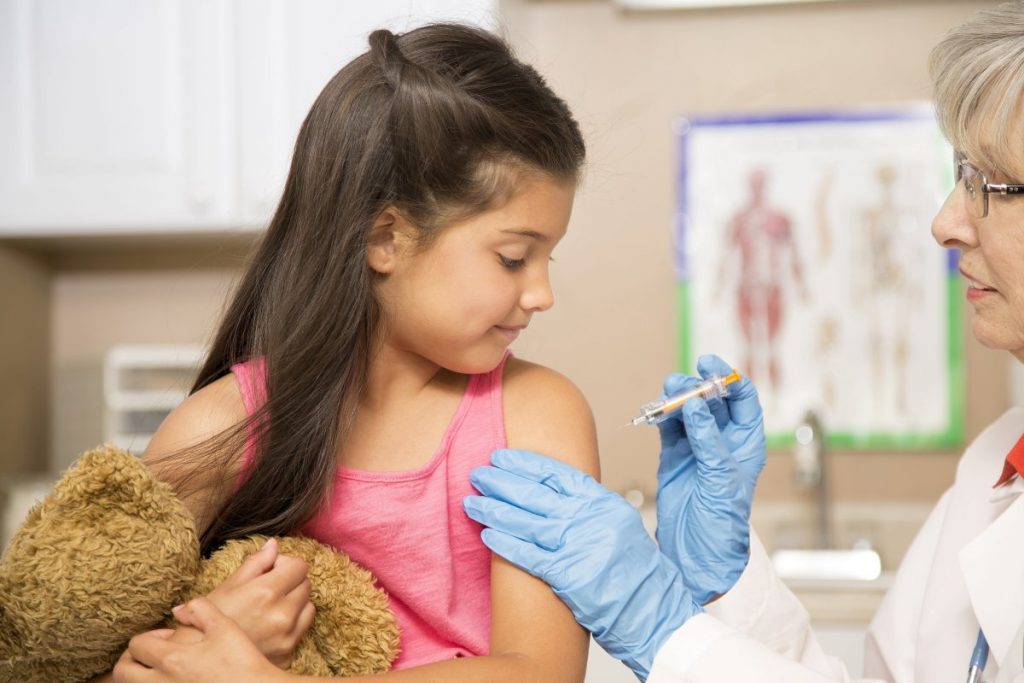
Prostock-studio/Shutterstock.com
Vaccination is considered to be one of the best methods of preventing tick-borne encephalitis. It is widespread in tick endemic areas.
Its principle consists in the introduction of the vaccine, after which the child develops immunity to the virus due to the formation of antibodies. If the child is bitten by an infected tick, infection either does not occur at all, or the disease will take place in a mild form.
If a tick has bitten a child, the vaccination will already be meaningless. In the treatment of tick-borne encephalitis, immunoglobulins are used, and if the vaccine is introduced, then its constituent substances will worsen the work of immunoglobulins.
In this case, vaccination resorts to no earlier than two weeks. If parents want to protect the child and introduce the vaccine in advance, here are the two schemes for doing so:
- Standard (planned): two vaccines with an interval of three months. Revaccination after a year, then every three years to maintain immunity.
- Emergency: 2 injections two weeks apart for those who move to endemic areas with tick-borne encephalitis, due to business trips or permanent residence.
You need to start routine vaccination in autumn, so that the second injection can be administered in the spring. Immunity is developed after 2-2.5 weeks. Life-long immunity does not occur in a child, therefore, revaccination should be carried out according to the scheme. The age at which this vaccine is started depends on the medicine.
Two main vaccines exist, one for the 1-16 years old age gap, and one for 16 years old and up. At present, no vaccine is registered for children below the age of 1-year-old.
It is important that the planned vaccine does not overlap with others on the vaccination schedule. The pediatrician will help you plan the right dates.
The vaccines against tick-borne encephalitis have got a number of the following contraindications:
- acute form of any disease (acute respiratory infections, bronchitis, tonsillitis, etc.);
- intolerance to the components and allergic reactions to the composition of the vaccine;
- vaccinations delivered less than 2 months ago;
- allergy to chicken protein and/or chicken meat;
- serious pathological changes in the liver, kidneys, blood diseases, etc.;
- immunodeficiency.
In any case, you should consult your pediatrician before vaccination. In the presence of contraindications, vaccination must not be done!

Prostock-studio/Shutterstock.com
Of course, there is a lot of debate about whether children should be vaccinated. Some people are afraid to do them because of possible side effects, among which are the following:
- skin rash;
- runny nose;
- redness of the skin in the area of the injection;
- fever;
- loss of appetite.
Experts call these symptoms a normal reaction to an injected substance. However, if the malaise does not go away for a long time, a doctor should be consulted.
With regard to vaccination against tick-borne encephalitis, it is important to understand that the disease itself is much more severe and that it accounts for much more consequences than the ailments after vaccination. The child may also feel unwell after any vaccination.
The following conclusions can be made with regards to the information presented above:
- The vaccine will allow one to experience mild tick-borne encephalitis or not get sick with it at all.
- The consequences after the injection can be in the form of ailments and this is absolutely normal.
- Only parents are responsible for the health of their children. They are to make a decision about vaccination, whilst doctors can only recommend it.
As for tick-borne borreliosis, no vaccination against it exists. After the disease is diagnosed, the treatment with antibiotics begins.
To sum up, we can definitely say that ticks are worth our concern and that the rules of visiting the forest in spring and early summer cannot be neglected. Ideally, it is better to postpone such walks until hot weather, when tick activity decreases to almost zero. Nevertheless, if a trip to a forest area is planned, dress the child so that there are no exposed skin areas, and treat the clothes with special aerosols beforehand.
If a child has been bitten by a tick, do not panic. Several at-home methods for extracting it exist, in order to avoid dangerous consequences. Direct your attention to vaccination for prevention purposes. Vaccination is safe and it allows to minimize the risk of contracting tick-borne encephalitis.
Проверьте электронный ящик



















